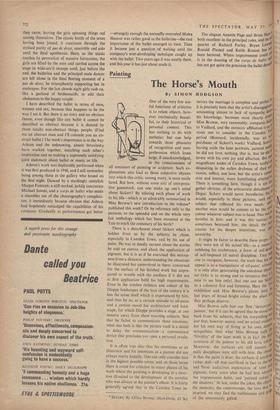Ballet
Find Me An Abstract Man
By CLIVE BARNES Tun Frederick Ashton/ Igor Stravinsky Scenes de Ballet never has been popular with the intel- lectually submerged nine- tenths of the ballet audience, and I suppose it never will be. The fact that the Royal Ballet have nursed it in their reper- tory for twelve years constitutes one of their rare gestures towards art as opposed to their more customary genuflections before box-office. Naturally performances are• few and far between, its revival last Saturday afternoon being the first for over two years. The typical matinee audience sucked their boiled sweets and crackled their chocolate papers, showing commendable stoicism under a cross- fire of Stravinsky's astringent music and Ashton's spare, classical choreography. They applauded at the end with a certain damp apathy only en- livened with barely inaudible relief. The revival had apparently filled no long-felt want, even though Scenes de Ballet is one of the few master- pieces in the British repertory. The ballet has a strange history. The score was commissioned from Stravinsky in 1944 by Billy Rose for a New York revue, The Seven Lively Arts, when it featured Markova and Dolin. Stravinsky has described the music as being `patterned after the forms of the classical dance, free of any given literary or dramatic argument. The parts follow each other as in a sonata or in a symphony, in contrasts or similarities.' This music, which still has to establish itself in the concert hall, was taken by Ashton four years later and made into a most remarkable ballet.
It starts with the curtain rising on five male dancers in front of an architectural setting. The principal dancer in the centre of the stage dances with arrogant deliberation, while the four other men negligently take up Michelangelo poses in the corners. After, this nearly static introduction all five bound off and twelve girls come threading in, with virgin tentativeness, through one of the arches at the back of the stage. They dance as ,three groups of four in sequence, each group following a pattern in the score like singers in canon. The four men in close formation sweep across the stage diagonally. Then, having made this first aggressive sortie with the unique self- absorption of athletes, they hurtle off the way they came, leaving the girls spinning things out among themselves. The classic battle of the sexes having been joined, it continues through the stylised purity of pas de deux, ensemble and solo until the final apotheosis. Here, as the music reaches its peroration of massive harmonies, the girls are lifted by the men and carried across the stage in wide-arc'd swoops until, just before the end, the ballerina and the principal male dancer are left alone in the final fleeting moment of a pas de deux, he triumphantly supporting her in arabesque. For the last chords eight girls rush on, like a garland of bridesmaids, to add their obeisances to the happy couple.
I have described the ballet in terms of men, women and sex, because that happens to be the way I see it. But there is no story and no obvious theme, even though like any ballet it cannot be described as abstract because it is danced by those totally non-abstract things, people. (Find me an abstract man and I'll concede you an ab- stract ballet.) The work's importance is in the way Ashton and the unknowing, absent Stravinsky have worked together, matching each other's inspiration and so making a supremely satisfying joint statement about ballet or music or life.
Ashton's work was deplorably performed when it was first produced in 1948, and I still remember being among those in the gallery who booed on the first night. Danced by a startlingly unstylish Margot Fonteyn, a stiff-necked, jerkily inaccurate Michael Somes, and a corps de ballet who made a shambles out of the choreography's complexi- ties, it immediately became obvious that Ashton had hopelessly misjudged the capabilities of his company. Gradually as performances got better —strangely enough the normally overrated Moira Shearer was rather good as the ballerina—the real importance of the ballet emerged to view. Then it became just a question of waiting until the company's ever-developing technique caught up with the ballet. Two years ago it was nearly there, and this year it has just about made it. The elegant Annette Page and Brian Shaw's both excellent in the principal roles, and the °lit quartet of Richard Farley, Bryan LBO Ronald Plasted and Keith Rosson has lir.; been bettered. Where improvement could nA'' is in the dancing of the corps de ballet 01F, has not got quite the precision the ballet denlav







































 Previous page
Previous page